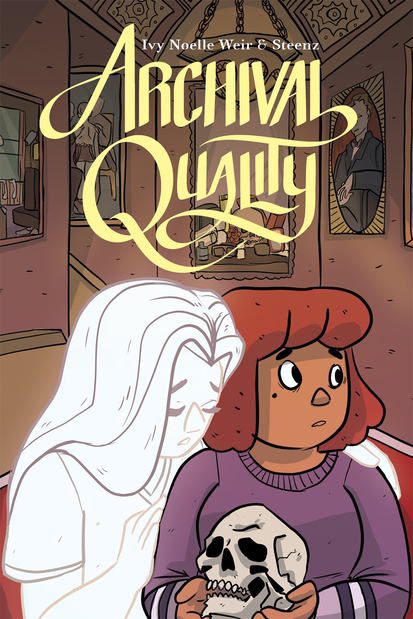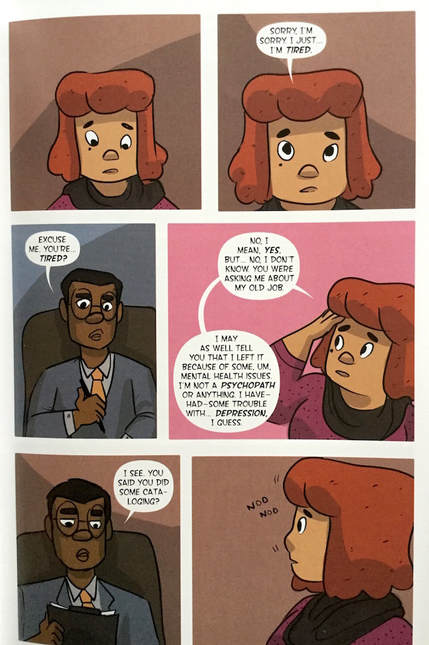|
Archival Quality. Written by Ivy Noelle Weir, illustrated and colored by Steenz. Oni Press, March 2018. ISBN 978-1620104705. $19.99, 280 pages. A Junior Library Guild Selection. Archival Quality, an original graphic novel out this week, tells the story of a haunted museum: a ghost story. It also tells about living with mental illness. The protagonist Cel, a librarian struggling with anxiety and depression, takes a job as archivist of a spooky medical museum that once served as an asylum (my friend, medical archivist and comics historian Mike Rhode, should check this out). The catch: she has to live in an apartment on the premises and do her work only in the dead of night. Soon she begins to witness... happenings that she cannot explain. Her boss, the museum's curator, and her coworker, a librarian, tiptoe around her, knowing more than they will say. Cel, who lost her previous job due to a breakdown, is understandably perplexed and triggered by their evasions, and by the fact that no one seems to believe her reports of odd doings. She begins to have frightful dreams: flashbacks that evoke the shadowy history of women's mental health treatment. The plot, which like many ghost stories gestures toward the fantastic (as Todorov defined it), finally veers toward the outright marvelous as Cel investigates the case of a young woman from long ago whose presence still lingers about the place. Cel, as she works to solve that case, is by turns fragile and angry, defensive and determined—a complex character, as is the curator, at first her foil, later her ally. The story takes quite a few turns. To be honest, Archival Quality's title and look did not prepare me for its uneasy exploration of mental health treatment—or rather, the social and psychiatric construction of mental illness. As I read through the novel's first half, Steenz's drawing style struck me as too light, undetailed, and schematically cute for the story's atmosphere of updated Gothic. Cel, with her snub nose, button eyes, and moplike hair, reminded me strongly of Raggedy Ann, and in general Steen's characters have a neotenic, doll-like quality. The settings seemed too plain to conjure up mystery and dread; the staging seemed too shallow, with talking heads posed before blank fields of color or swaths of shadow, lacking particulars. Steenz favors air frames (white borders around the panels, rather than drawn borderlines) and an uncluttered look. This did not jibe with my expectations of the ghost story as a genre. But as the plot deepens, and Cel's dreams and visions overtake her, Weir and Steenz together generate suspense. The pages deal out a number of small, quiet shocks: Further, Steenz's sensitive handling of body language brings the characters, doll-like as they are, to life. The book becomes tense, involving, and, as we say, unputdownable. Weir and Steenz's back pages tell us that the two enjoyed a close working relationship, and you can tell this from the story's anxious unwinding. This is unusually strong storytelling, and a complicated, coiled plot, for a first-time graphic novel team. Clearly, Weir and Steenz are simpatico artistically—and ideologically too, I think, sharing a progressive and feminist outlook that shapes cast, character design, characterization, and plot. I will admit that not everything about Archival Quality works for me. The plot, on the level of mechanics, seems juryrigged and farfetched, that is, determined to pull characters and elements together for the sake of symbolic fitness, without the sort of realistic rigging that the novel seems to be striving for. In other words, certain things happen simply because they have to happen. Further, some elements of the story, rather big elements I think, are palmed off in the end because Weir and Steenz don't seem to be interested in working out the details. At the closing, I had the feeling that a Point was being made, rather than a novel being rounded off (to be fair, I often react this way to YA fiction, even though I know that didacticism is crucial to the genre). Still, Archival Quality, behind its coy title, offers a gutsy exploration of mental health treatment, an eerie ghost story, and characters who renegotiate their relationships with credible human frailty and charm. A most promising print debut, and a keeper.
0 Comments
Your comment will be posted after it is approved.
Leave a Reply. |
Archives
June 2024
|





 RSS Feed
RSS Feed
